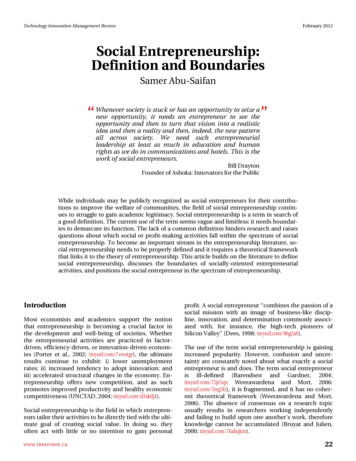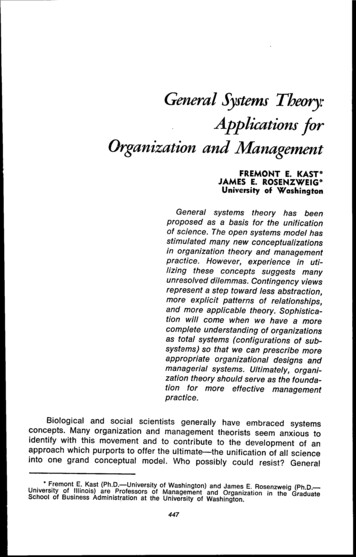
Transcription
Technology Innovation Management ReviewFebruary 2012Social Entrepreneurship:Definition and BoundariesSamer Abu-Saifansociety is stuck or has an opportunity to seize a“ Whenevernew opportunity, it needs an entrepreneur to see the ”opportunity and then to turn that vision into a realisticidea and then a reality and then, indeed, the new patternall across society. We need such entrepreneurialleadership at least as much in education and humanrights as we do in communications and hotels. This is thework of social entrepreneurs.Bill DraytonFounder of Ashoka: Innovators for the PublicWhile individuals may be publicly recognized as social entrepreneurs for their contributions to improve the welfare of communities, the field of social entrepreneurship continues to struggle to gain academic legitimacy. Social entrepreneurship is a term in search ofa good definition. The current use of the term seems vague and limitless; it needs boundaries to demarcate its function. The lack of a common definition hinders research and raisesquestions about which social or profit-making activities fall within the spectrum of socialentrepreneurship. To become an important stream in the entrepreneurship literature, social entrepreneurship needs to be properly defined and it requires a theoretical frameworkthat links it to the theory of entrepreneurship. This article builds on the literature to definesocial entrepreneurship, discusses the boundaries of socially-oriented entrepreneurialactivities, and positions the social entrepreneur in the spectrum of entrepreneurship.IntroductionMost economists and academics support the notionthat entrepreneurship is becoming a crucial factor inthe development and well-being of societies. Whetherthe entrepreneurial activities are practiced in factordriven, efficiency-driven, or innovation-driven economies (Porter et al., 2002; tinyurl.com/7vwutgr), the ultimateresults continue to exhibit: i) lower unemploymentrates; ii) increased tendency to adopt innovation; andiii) accelerated structural changes in the economy. Entrepreneurship offers new competition, and as suchpromotes improved productivity and healthy economiccompetitiveness (UNCTAD, 2004; tinyurl.com/d3xkdj4).Social entrepreneurship is the field in which entrepreneurs tailor their activities to be directly tied with the ultimate goal of creating social value. In doing so, theyoften act with little or no intention to gain personalwww.timreview.caprofit. A social entrepreneur “combines the passion of asocial mission with an image of business-like discipline, innovation, and determination commonly associated with, for instance, the high-tech pioneers ofSilicon Valley” (Dees, 1998; tinyurl.com/86g2a6).The use of the term social entrepreneurship is gainingincreased popularity. However, confusion and uncertainty are constantly noted about what exactly a socialentrepreneur is and does. The term social entrepreneuris ill-defined (Barendsen and Gardner, 2004:tinyurl.com/75jr5sp; Weerawardena and Mort, 2006:tinyurl.com/7erg5lz), it is fragmented, and it has no coherent theoretical framework (Weerawardena and Mort,2006). The absence of consensus on a research topicusually results in researchers working independentlyand failing to build upon one another’s work, thereforeknowledge cannot be accumulated (Bruyat and Julien,2000; tinyurl.com/76ahqkm).22
Technology Innovation Management ReviewFebruary 2012Social Entrepreneurship: Definition and BoundariesSamer Abu-SaifanThere is a need to better define what is meant by theterm social entrepreneur. How are social entrepreneursdifferent from other entrepreneurs? How are social entrepreneurs different from managers of social workers?What constitutes social entrepreneurship and whatdoes not?In this article, we first review some of the literature discussing the definition of entrepreneurship and thenprovide a clear and concise definition of social entrepreneurship. Next, we identify the unique features ofsocial entrepreneurs and suggest boundaries for socialentrepreneurship.Characteristics of EntrepreneurshipSocial entrepreneurship needs to be defined in a waythat is consistent with what is known about entrepreneurship. This section identifies the characteristics of theentrepreneur.According to the business management literature, entrepreneurship is an exceptional set of activities carriedout by individuals with an exceptional mind-set in order to maximize profit. Therefore, the process is closelytied to success. We use “exceptional mind-set” as abroader term to encapsulate the characteristics thatshape the entrepreneurial activities of those individuals(see Table 1). The business literature differentiates entrepreneurs from business people by including statements such as: entrepreneurs “create needs”; whilebusiness people “satisfy needs” (2010 Global com/8xzvv3p). Entrepreneurs are conceptualized asindividuals who see the world differently and envisionthe future better than others do. They seize opportunities that otherwise would go unnoticed. They perceiveand accept risks differently than others. Table 1 showsthe core characteristics of entrepreneurs, as extractedfrom full or partial definitions in the literature on venture creation, opportunity exploitation, and profit mist’s view of an entrepreneur as an individualwith an exceptional mind-set; individuals with such amind-set are seen as key to venture growth maximization and economic prosperity.Table 1. Contrasting definitions and core characteristics of the terms “entrepreneur” and “entrepreneurship”www.timreview.ca23
Technology Innovation Management ReviewFebruary 2012Social Entrepreneurship: Definition and BoundariesSamer Abu-SaifanCharacteristics of Social EntrepreneurshipAlthough the use of the term social entrepreneur is growing rapidly, the field of social entrepreneurship lacksrigour and is in its infancy compared to the wider field ofentrepreneurship. Success stories of individuals solvingcomplex social problems are being used to legitimize thefield of social entrepreneurship. For example, in 2004,Stanford University launched Social E Lab (socialelab.org)as part of its Entrepreneurial Design for Extreme Affordability course, which promotes the use of entrepreneurship principles to solve social and environmentalproblems. The program spun off a number of successful projects, including DripTech (driptech.com), ProjectHealthy Children (projecthealthychildren.org), and Embrace(embraceglobal.org). Other examples of well-established organizations that are frequently referenced in the literature on social entrepreneurship include: Ashoka(ashoka.org), OneWorld Health (oneworldhealth.org), TheSkoll Foundation (skollfoundation.org), and the SchwabFoundation for Social Entrepreneurship (schwabfound.org).However, the field is arguably phenomenon-driven(Mair and Martı , 2005; tinyurl.com/7ubxt5q) and fallsshort when compared to areas that are perceived tohave greater rigour applied to them. As evidence of this,scholars have yet to link social entrepreneurship to thetheory of entrepreneurship and knowledge.The interest in social entrepreneurs stems from theirrole in addressing critical social problems and the dedication they show in improving the well-being of society (Zahra et al., 2008; tinyurl.com/87upzh3). The publicoften hold social entrepreneurs in high regard becauseof the multitude of social needs they satisfy and the improved life quality they bring to affected societies.When comparing the definitions and characteristics ofentrepreneurs (Table 1) with those of social entrepreneurs (Table 2), we see that the ultimate goal of an entrepreneur is to create economic wealth whereas, for asocial entrepreneur, the priority is to fulfill their socialmission. Social entrepreneurs design their revenue-generating strategies to directly serve their mission to deliver social value.Table 2. Contrasting definitions and core characteristics of the terms “social entrepreneur” and “social entrepreneurship”www.timreview.ca24
Technology Innovation Management ReviewFebruary 2012Social Entrepreneurship: Definition and BoundariesSamer Abu-SaifanDefining Social EntrepreneurshipIn this section, we build on the definitions presented inTable 2 and propose a definition that captures the keyfactors that are vital to social entrepreneurship. We hopethat our definition will reduce the constantly perceivedvagueness about the field, identify the scope of relatedresearch, and accelerate the advancement of social entrepreneurship as a legitimate academic research field.We propose the following definition:The social entrepreneur is a mission-driven individual who uses a set of entrepreneurial behaviours todeliver a social value to the less privileged, all throughan entrepreneurially oriented entity that is financiallyindependent, self-sufficient, or sustainable.This definition combines four factors that make socialentrepreneurship distinct from other forms of entrepreneurship. Social entrepreneurs:1. are mission-driven. They are dedicated to serve theirmission of delivering a social value to the underserved.2. act entrepreneurially through a combination of characteristics that set them apart from other types of entrepreneurs (see Table 3).3. act within entrepreneurially oriented organizationsthat have a strong culture of innovation and openness.4. act within financially independent organizationsthat plan and execute earned-income strategies. Theobjective is to deliver the intended social value whileremaining financially self-sufficient. This is achievedby blending social and profit-oriented activities toachieve self-sufficiency, reduce reliance on donationsand government funding, and increase the potential ofexpanding the delivery of proposed social value (Bacqet al., 2011; tinyurl.com/7nry6jp).Table 3 summarizes the unique characteristics ofprofit-oriented and social entrepreneurs presented inTables 1 and 2 and identifies those characteristicsthat are most likely to be found in both types of entrepreneurs.Table 3. Unique and common characteristics of profit-oriented entrepreneurs and social entrepreneurswww.timreview.ca25
Technology Innovation Management ReviewFebruary 2012Social Entrepreneurship: Definition and BoundariesSamer Abu-SaifanBoundaries of Social EntrepreneurshipThis section distinguishes between social entrepreneurship and other non-entrepreneurial, mission-driven initiatives. As discussed earlier, the term socialentrepreneurship is becoming more popular and is attracting growing amount of resources. It is frequently observedin the media, used by public officials, and is commonly referred to by academics. This is in part because of the support social entrepreneurs are receiving from complexnetwork of organizations that highlight their work andcontributions to society (Dacin et al., 2011; tinyurl.com/7a9bh9d). However, the lack of consensus on the definitionof social entrepreneurship means that other disciplinesare often confused with and mistakenly associated with social entrepreneurship. Philanthropists, social activists, environmentalists, and other socially-oriented practitionersare referred to as social entrepreneurs. It is important toset the function of social entrepreneurship apart from other socially oriented activities and identify the boundarieswithin which social entrepreneurs operate.According to the Skoll Centre for Social Entrepreneurship, the definition of social entrepreneurship shouldnot extend to philanthropists, activists, companies withfoundations, or organizations that are simply sociallyresponsible (tinyurl.com/yd8ggyq). While all these agentsare needed and valued, they are not social entrepreneurs.Building on our proposed definition of social entrepreneurship, we propose boundaries to properly position social entrepreneurs in the spectrum of entrepreneurship.As illustrated in Figure 1, social entrepreneurs operatewithin the boundaries of two business strategies:1. Non-profit with earned income strategies: a socialenterprise performing hybrid social and commercial entrepreneurial activity to achieve self-sufficiency. In thisscenario, a social entrepreneur operates an organization that is both social and commercial; revenues andprofits generated are used only to further improve thedelivery of social values.Figure 1. The entrepreneurship spectrum illustrating the boundaries of social entrepreneurshipwww.timreview.ca26
Technology Innovation Management ReviewFebruary 2012Social Entrepreneurship: Definition and BoundariesSamer Abu-Saifan2. For-profit with mission-driven strategies: a socialpurpose business performing social and commercialentrepreneurial activities simultaneously to achievesustainability. In this scenario, a social entrepreneuroperates an organization that is both social and commercial; the organization is financially independentand the founders and investors can benefit from personal monetary gain.Recommended ReadingThe Rise of the Social Entrepreneurby Charles Leadbeatertinyurl.com/7exweb6ConclusionAbout the AuthorSocial entrepreneurship has recently emerged as a fieldof academic inquiry, but the lack of a common definition of social entrepreneur impedes research in thisfield. In this article, we reviewed literature that definedprofit-oriented entrepreneurship and social entrepreneurship in order to extract the core characteristics ofeach type. We then proposed a definition of social entrepreneurship, which contributes to the literature onsocial entrepreneurship by clarifying and bounding thescope of research in this field.Samer (Sam) Abu-Saifan is the Head of InformationTechnology for Street Haven at the Crossroads, anot-for-profit organization in Toronto. With over 15years of experience managing complex technologyenvironments, Sam has held positions in businessdevelopment, change management, and innovationmanagement. He received a BS in Computer Information Systems from Amman University, Jordan, anda Business Management Certificate from RyersonUniversity, Toronto. Currently, he is pursuing a Master’s degree in Technology Innovation Managementat Carleton University, Ottawa. In 2011, Sam founded Autism Ottawa (Ottism), a social purpose business that will use innovative technologies to delivereducational services to children and families livingwith autism.Social entrepreneurship has flourished significantly atthe practical level, but not at the theoretical level. Futureresearch should focus on linking social entrepreneurshipas a new discipline and research field to the theory of entrepreneurship. Scholars should also focus their attention on introducing new research questions that aremeaningful to the different domains that intersects withsocial entrepreneurship, including social innovation andthe management of non-profit organizations.www.timreview.caCitation: Abu-Saifan, S. 2012. Social Entrepreneurship:Definition and Boundaries. Technology InnovationManagement Review. February 2012: 22-27.27
Definition and Boundaries Samer Abu-Saifan Introduction Most economists and academics support the notion that entrepreneurship is becoming a crucial factor in the development and well-being of societies. Whether the entrepreneurial activities are practiced in factor-driven, efficiency-driven, or innovation-driven econom-










